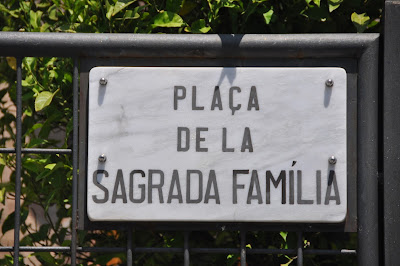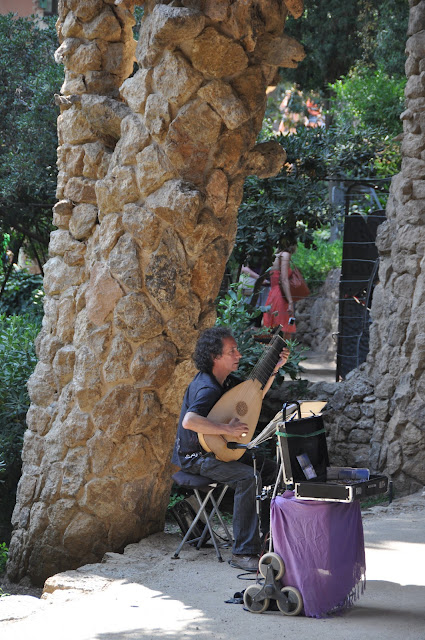We then drove into the heart of Barcelona (our homestay was in the town called 'Canet de Mar') and went to a restaurant (after a little time in a mall) where we learned to make...and made.. Paella! It was delicious!
See the juggler? We saw this multiple times...you'd be at a red light, they would come out and juggle or do some other trick...and then come by your window with a hat for money!
We then met 'Amada,' our guide for the day. She told us we would learn about Gaudi, a famous architect from Barcelona. Two of his masterpieces we got to see. The first was a church, La Sagrada de Familia, and the second is a park.
Driving to the park, we first passed a gherkin looking building that is covered in solar panels that light up at night with LED lights. It's the headquarters for a water company and is a totally self-sustained building!
Barcelona is the 2nd largest city in Spain with 3.5 million people. The largest city is Madrid and the 3rd largest is Valencia. Spain has a population of 47 million people...but, listen to this, they have between 54-57 million visitors a year! Obviously, tourism is a HUGE part of their economy.
We first went to see La Sagrada de Familia! The official name is Basilica de Sagrada de Familia. If you've never heard of it (I hadn't), it is...well, I guess amazing is the word. It's very unique and it's still not completed, even though it was started in 1882! It's not used since it's not finished. The money to build it only comes from charity, no money comes in from the government or from the Vatican. Tourism is up since the economy is better, so they are getting more money from that. It's estimated, at this point, to be finished in 2026! Gaudi died in 1926, so the goal is to have it completed on the 100th anniversary of his death.
See the fruits? They represent fruits from this area
Darker part completed by 1926...lighter part after 1926
4 of the towers representing the apostles
Birth of Jesus
Cypress tree
Gaudi was 34 years old when he started this .. and was 74 when he died. He worked on it until his death...which came from being run over while he was working. :( He was born about an hour from Barcelona in 1852 and came here to study architecture. In 1878 he became an architect. He never married, living alone, and just living for his architecture. He didn't care about having lots of money and wouldn't take any more work for the last 14 years of his life...only concentrating then on La Sagrade de Familia.
While he was alive, not so many people liked his work because he was so innovative. However, Amada told us that now, 99% of the people accept and like his work. He also designed houses and apartment buildings...where the only thing straight, was the floor!
In the photos you can see a darker colored stone which is the part that was completed while he was alive.
One side entrance has engravings/statues representing the birth of Jesus. There are 4 towers, each 350' tall. There will be 4 towers on 3 different sides, representing the 12 apostles. In the middle, there will be a 560' tower to represent Jesus. There are 7 architects currently working on how to design and build this tower and the rest of the church. Eventually, there will be 4 more towers added to represent the four gospels.
The opposite side represents the crucifixion of Jesus. This side was started in 1957 and has writing in Latin. It's a more expressive side...more dramatic...more contemporary.
All those buildings on the right side of the photo...and more...will all be demolished for the gardens.
When workers go up in this scaffolding in the mornings to work, they don't come down all day. Everything you need for the day is there...bathrooms, microwaves...everything!
From there, we went to Guell Park...or "Parc Guell" or 'The Garden City in Barcelona'. A man named Guell (can't remember anything about him) bought 38 acres in 1900 and he wanted Gaudi to do the work. It has a little mountain on that 38 acres and he divided the land into 60 plots thinking they could build 60 houses. However, he only sold one plot because the people of Barcelona weren't interested in moving up to this area. It is a little bit out from the center of town, and in those days, you got around by walking or carriage. In Barcelona now, it's interesting because no one lives in houses, they all live in condominiums! This area became a park in 1926 and in 1984 became a UNESCO World Heritage Site.
Armada...our guide
Columns are built to look like trees...rocks used are from here because Gaudi always liked to use local materials. Little indentions were made for birds!
The pink house was the 'show house'. Gaudi did NOT design this, but he bought it in 1906 and kept it for the last 20 years of his life. Because he lived alone, he spent most of his time at La Sagrada de Familia, and not here.
The wall built in a semi-circle was built in the design of palm trees.
The tile seating area built around the square, was built to be very ergonaumic...and it is very comfortable on your back!
These columns supporting the square...these are the empty ones that the water drains through.
There is an area underneath this square that is supported by columns. The columns are empty...and water collects on top, comes down through the columns, and is stored in a cistern underneath! Gaudi designed mosaics in the ceiling...all of recycled materials.
Two 'houses' we saw are nicknamed the Witches house...and Hansel and Gretal's house. The witches house has a poison mushroom on top. When I asked about the mushroom on top of Hansel and Gretal's house, Amada said, "Oh, that's a good mushroom."
Some more random photos from the park:
After leaving the park, Amada stayed with us a little longer and told us a little more about the city of Barcelona. In 1850, the city planned an enlargement. All intersections have crossed streets at 90 degree angles. Streets are also one way and they are wide- with 3 or 4 lanes of traffic. The corners are cut as triangles. In those days, the planners thought trains would be the mode of transportation, so the cut corners would make it easier for turns. No building is more than 7 stories tall. In the 1880's, the bottom floor was the most desired and the most expensive because there were no elevators. After the introduction of elevators, the situation reversed. The top floors became more desired and expensive because they were lighter and quieter than those on the street.
Probably the most popular street is La Rambla...it is PACKED! Packed with shops and packed with people. It's one mile long...and Amada told us you won't find any local people there...only tourists. We were 43 of the tourists there on July 5th!
For dinner, we headed to Patio Andaluz, a theater restaurant where we saw an authentic Flamenco dance show.
Then it was time to head to our hotel and call it a night!


























































































































No comments:
Post a Comment